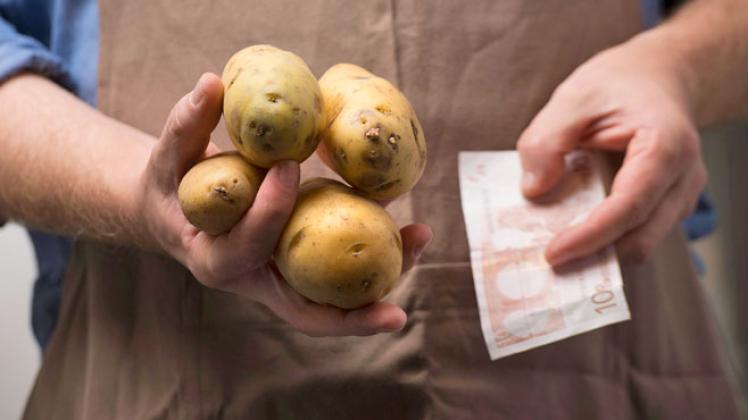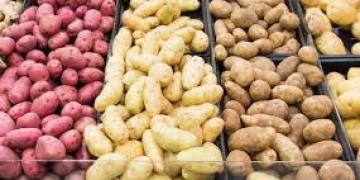Nutrición: Calcium s role in potato quality, production
Calcium plays an important role in the growth and development of plants. Cell membrane health is very crucial to the survival and health of the plant cell.

The health of the cell membranes can only be maintained in the presence of sufficient Ca around the membranes. Calcium is also an integral part of the cell wall where it provides stable but reversible intra-molecular linkages between pectin molecules, resulting in cell wall rigidity. In addition, calcium is known to act like a hormone, thus regulating many growth and developmental processes in plants.
Calcium in plants moves with water and tubers are naturally deficient in calcium
Tubers are botanically a stem tissue. As compared to the above-ground stem portion of the plant, tubers contain very little calcium. Transpiration is the main driving force for calcium transport in plants. Calcium therefore moves along with water in the xylem. Low-transpiring organs such as fruits and tubers are known to suffer from Ca deficiency. Potato tubers, being surrounded by moist soil, will have much less transpiration than above-ground parts of the plant. Consequently, low-transpiring tubers accumulate much less calcium than leaves and above ground stems. Deficiency of calcium in tuber tissue is even greater for potatoes grown in sandy soil because of the very low level of water soluble Ca in these soils. Moreover, with irrigation and rain, the water-soluble Ca is often leached from the hill. Thus, the soil surrounding the tubers will contain very low soluble calcium, especially during the mid and late part of the season when tubers develop.
Tubers get calcium from the surrounding soil via tiny roots on the tubers and stolons
Since tubers are surrounded by relatively moist soil, they cannot compete with leaves for transpirational water uptake. Tubers have to rely on the roots that are in their close proximity (tuber roots, tuber– stolon junction roots, and stolon roots) to transport water from the soil. Since calcium moves in the xylem along with the water, it follows that potato tubers must transport calcium from the soil in their close proximity. That means that both placement and timing of calcium fertilizer important to enhance tuber calcium.
Most effective way to enhance tuber calcium is to deliver water-soluble calcium fertilizer by feeding into the irrigation line
Since tubers develop during the mid to late part of the season, it would be important to add supplemental calcium during tuber bulking, which is very critical in sandy soils. Due to low moisture holding capacity, sandy soils are often irrigated 2–3 times a week. Thus, the top portion of the hill is continuously washed by the irrigation and rain with water, moving soluble nutrients to the lower portion of the hill. These nutrients remain accessible to vegetative growth via the main root system. However, the tubers developing during late season will not have access to these nutrients via the tuber and/or stolon roots.
Therefore, an effective way to enhance soluble calcium in the hill is to deliver liquid calcium fertilizers through the irrigation water during the tuber bulking period. Liquid fertilizers containing either calcium nitrate or calcium chloride as a source of calcium are available. In most of our studies at the University of Wisconsin, we used about 100-150 lbs of calcium per acre, which was applied in three or four split applications (2-3 week intervals) starting at tuber initiation stage. When a calcium source contains N, such as calcium nitrate, the N application should be adjusted to get the desired total N for the season.
What are the options under non-irrigated conditions?
As stated previous, tubers take up calcium from the surrounding soil; thus, placing the calcium fertilizer in the hill is the best way to enhance calcium uptake by the tuber. When applying the calcium through irrigation equipment is not an option, it is best to apply calcium at the last hilling time, mixing the product into the soil. In sandy soils, because of the high potential of leaching soluble calcium from the top of the hill, it may be better to use less soluble products such as gypsum. In heavier soils, soluble products such as granular calcium nitrate can be incorporated into the hill.
Can we use soil tests as a guide to determine calcium fertilizer rate?
In our studies, potatoes responded positively to inseason soluble calcium application grown on soils with exchangeable calcium of 300-1300 ppm. This amounts to 600-2600 lbs of exchangeable calcium per acre. From this wide range, it can be seen that soil tests are not a reliable measure to determine tuber needs for calcium. It appears most of the soil calcium is not readily water-soluble and therefore not available to the tuber. Of course, the higher the soil test calcium, the better it is for the tuber calcium uptake. In addition, calcium as a part of the total base saturation of the soil is important. A good soil should contain at least 60% Ca of the total bases (Ca+Mg+K).
Calcium can influence stem number, tuber set and size
In general, an increase in soil calcium results in reduction in stem numbers, which translates into fewer but larger tubers. This will depend on the soil test calcium. If the soil test shows already high soil calcium, this effect may not be as significant.
What is the desired level of calcium in the tuber tissue we are targeting?
Tuber calcium concentration is a genetic trait and varies among varieties. In general, russet varieties tend to have higher tuber calcium concentration than the chip varieties. However, all varieties respond positively to inseason calcium fertilization. In many cultivars, calcium concentration of about 200 ppm in the internal tuber tissue is considered desirable.
What are the benefits of calcium application?
Reduced storage rot
Reduced incidences of internal defects, including hollow heart, brown spots, black spot bruise
Reduced impact of heat and cold stresses on plant and reduced incidence of internal heat necrosis of tuber
Improved seed piece quality and sprout health (more robust plant). The growing sprout from the seed tuber gets calcium initially (before root system develops) from the seed tuber. If the seed tuber is deficient in calcium, the sprout tip can be damaged, resulting in growth of the side branches and leading to an increase in stem number. This would result in an in increase tuber set and reduced tuber size.
Source: Role of Calcium in Potato Quality and Production Factsheet, Jiwan P. Palta, professor, Department of Horticulture University of Wisconsin, Madison
TAGS: CALCIUM
Fuente: https://spudman.com/news/calciums-role-in-potato-quality-production/




